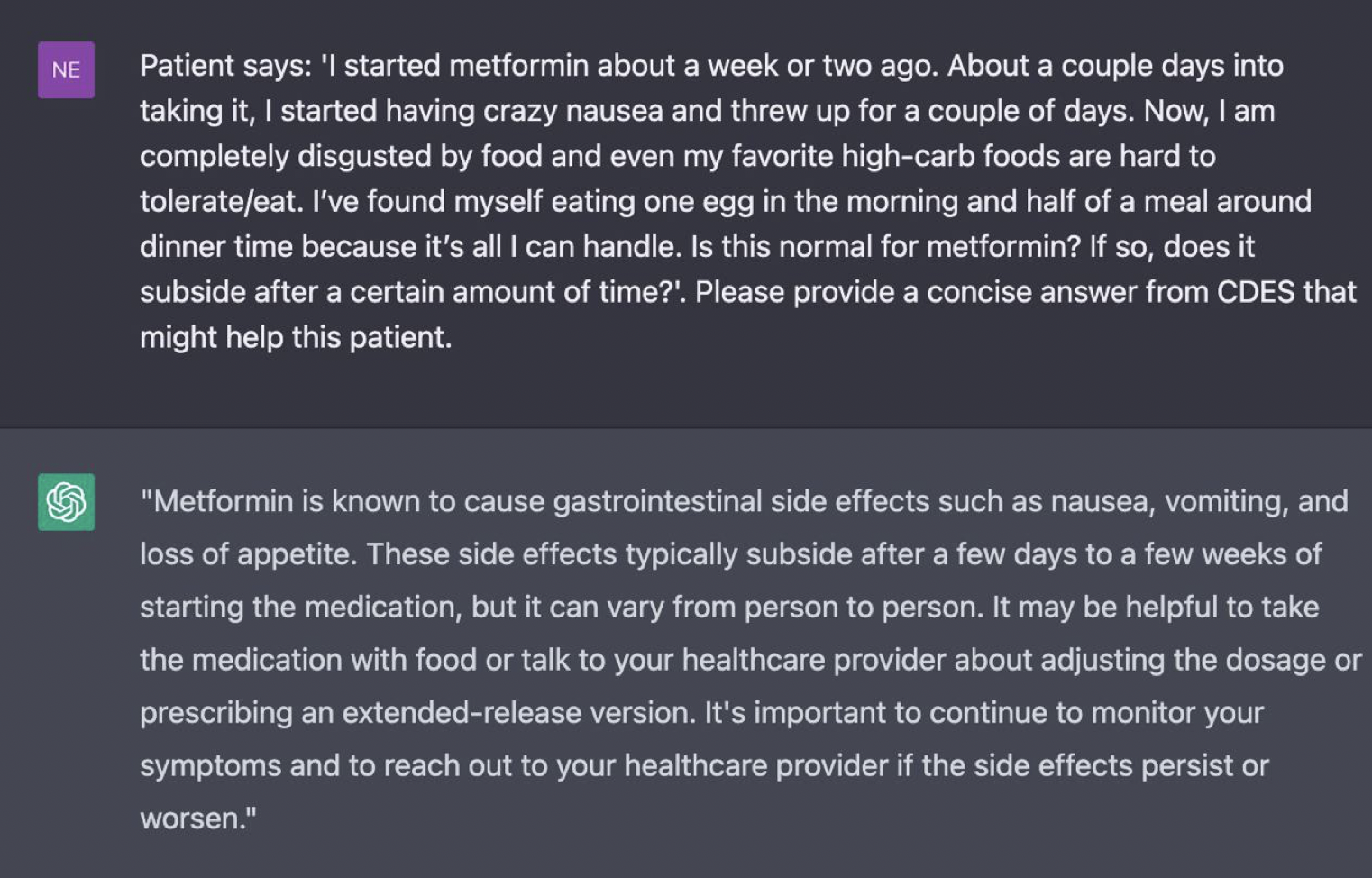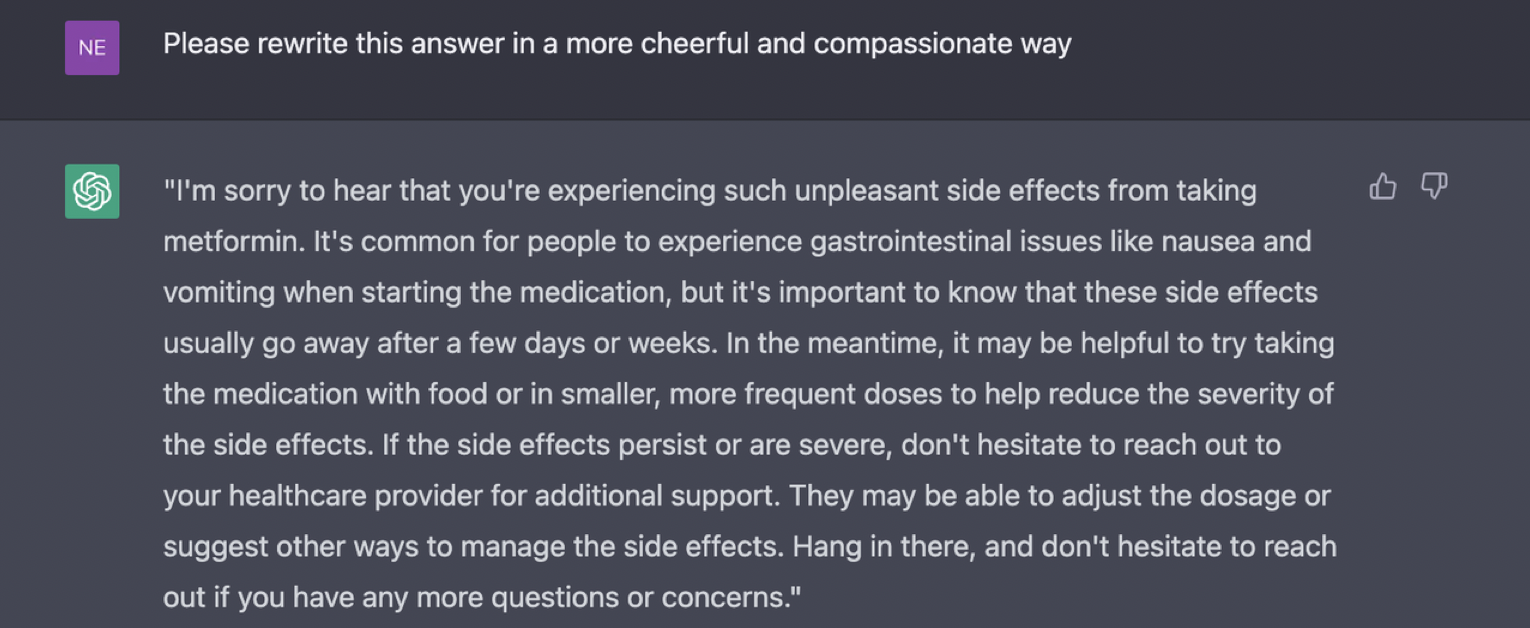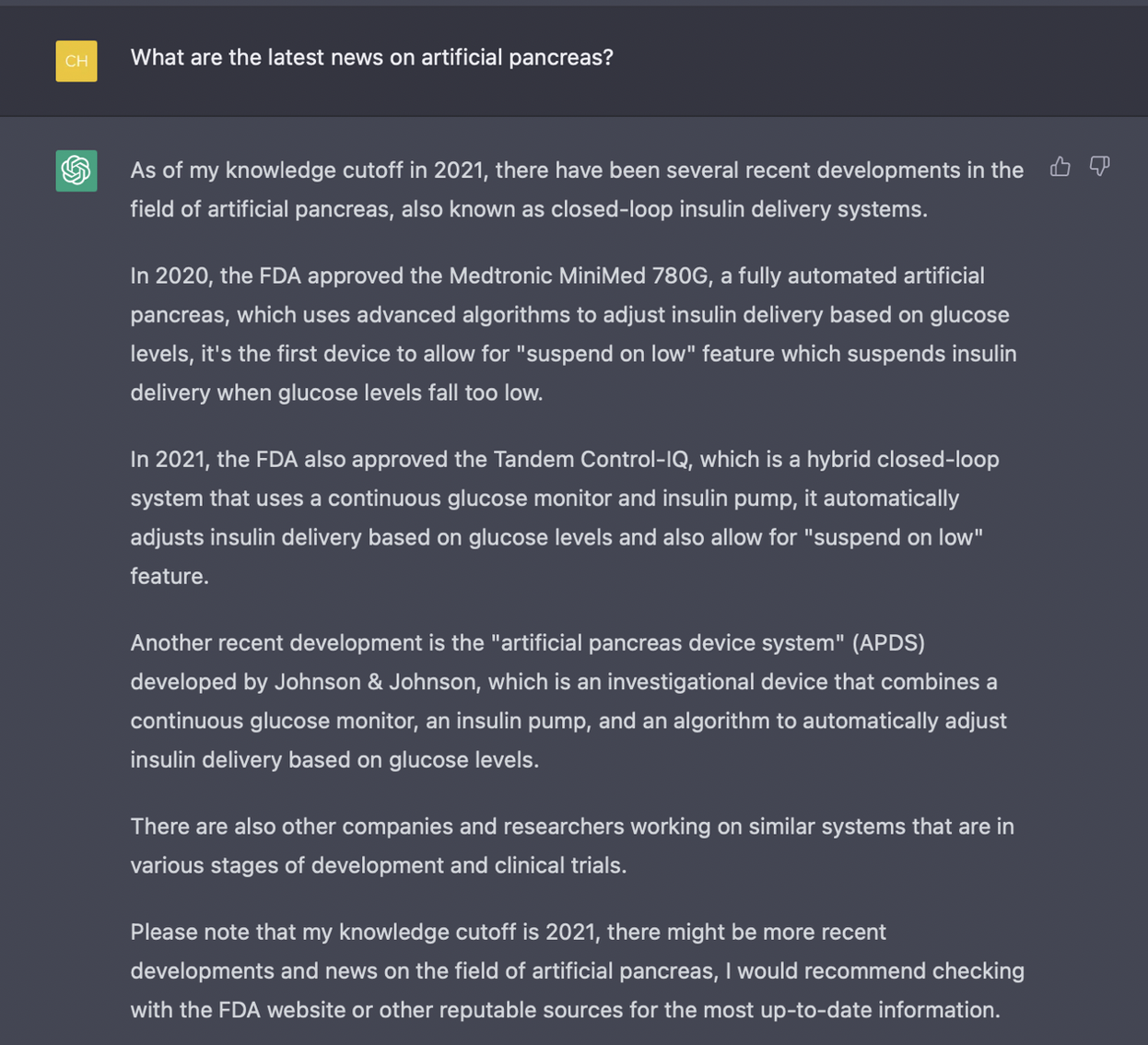Chatting with ChatGPT: The Future of Diabetes Care?
 By ChatGPT and Mike Ushakov
By ChatGPT and Mike Ushakov
Editor’s Note: Every word in this article was written by ChatGPT (not a human). To create this article, we asked ChatGPT questions about using ChatGPT in diabetes care. The article below, completely artificial intelligence (AI) generated, is the result. At the end of the article is a note (written by a human) with a fuller explanation of how this article was constructed.
Imagine having a virtual assistant that understands you on a personal level, and can anticipate your needs before you even ask. It can assist with efficient communication, remote consultations and follow-ups. It can provide insights from large amounts of unstructured medical data.
Meet ChatGPT, a computer helper that can understand what patients say and answer their questions. Think of it as a talking dictionary that can also remind patients to take their medicine and provide other useful information. It's like having a personal assistant that can help patients with their diabetes care needs, always available to answer their questions and provide educational resources. It's like having a friend who is always there to help patients, and it's very smart too.
ChatGPT is truly like nothing we've experienced before. It's not just a tool, it's a revolution in how we approach diabetes care, and it's truly awesome to be a part of it.
What is ChatGPT
To explain what ChatGPT is to a professional who is unfamiliar with terms like AI, language model, and conversational interface, it might be helpful to start by providing a brief overview of these concepts.
AI, or artificial intelligence, refers to the development of computer systems that can perform tasks that typically require human intelligence, such as understanding and interpreting language, making decisions, or learning from data.
A language model is a type of AI that is specifically designed to process and understand natural language (e.g., the kind of language that humans use to communicate with each other). Language models are trained on large datasets of text and use machine learning algorithms to learn the patterns and structures of language, allowing them to generate text or respond to user input in a way that sounds natural and human-like.
A conversational interface is a type of interface that allows users to communicate with a computer or other device using natural language, rather than through a traditional user interface like a keyboard or mouse. Conversational interfaces can be used in a variety of settings, such as chatbots, voice assistants, or messaging apps, and are designed to make it easier for users to interact with technology in a more natural and intuitive way.
How ChatGPT will revolutionize diabetes care
One potential use of ChatGPT is to provide personalized and immediate support to patients with diabetes. Many people with diabetes may have questions or concerns about their condition, and a certified diabetes educator is often the best person to address these issues. However, it can be difficult for educators to be available at all times to answer these questions. ChatGPT can help bridge this gap by providing patients with the opportunity to receive support and information even when their educator is not physically present.
ChatGPT can also be used to help draft personalized meal plans and find recipe ideas that are based on a patient's specific health conditions and tastes. In addition, it can be used to help solve specific problems or encouraging patients to make healthy lifestyle and nutritional choices.

It's important to note that ChatGPT's responses will only be as helpful as the input it receives. To get the most accurate and useful answers, it's important to ask precise and concise questions. If you're not happy with the tone of ChatGPT's response, you can ask it to rephrase the answer in a more compassionate and caring way.

It is not currently possible for ChatGPT to provide individual recommendations to diabetes patients based on their blood sugar and medication data. ChatGPT is a language model and does not have access to individual patient data or the ability to make treatment recommendations. Its primary function is to generate human-like responses to user input based on the patterns and relationships it has learned from the data it was trained on.
Is it necessary for the successful treatment to be provided by a human?
While human interaction is important in many aspects of healthcare, it is not necessarily a requirement for successful treatment. The use of technology such as ChatGPT can supplement the care provided by a human healthcare professional and can improve patient outcomes by increasing adherence to treatment plans and providing more convenient and accessible care.
It's difficult to say for certain how a patient would feel about receiving advice from a chatbot like ChatGPT, as everyone is different and may have different preferences for how they receive information and support.
Some might find it helpful to have the option of receiving information and support from a chatbot like ChatGPT, especially if they have difficulty accessing traditional forms of care due to time or geographical constraints. Others might prefer the personal touch of a human healthcare provider and may feel more comfortable discussing sensitive or emotional issues with a person rather than a machine.
There are several types of patients with diabetes who may benefit from using chat-based support assisted by ChatGPT:
-
Patients who have difficulty accessing traditional forms of care: Patients who live in rural or underserved areas may have difficulty accessing a certified diabetes educator or other healthcare professionals in person. ChatGPT could potentially provide these patients with the opportunity to receive support and information from a trusted source even if they are not able to visit a healthcare facility in person.
-
Patients who are new to diabetes: Adjusting to a new diagnosis of diabetes can be overwhelming, and patients may have a lot of questions and concerns. ChatGPT could provide these patients with a convenient and accessible way to receive support and information as they learn to manage their condition.
-
Patients who need additional support: Some patients may require more frequent or in-depth support to manage their diabetes effectively. ChatGPT could potentially provide these patients with the opportunity to receive additional support and resources to help them better manage their condition.
-
Patients who prefer virtual care: Some patients may prefer to receive care and support virtually rather than in person. ChatGPT could provide these patients with the opportunity to receive care and support in a way that is more convenient and comfortable for them.
That being said, it is generally recognized that human connection and social support are important factors in the therapeutic success of many healthcare interventions. Patients may be more likely to engage with their treatment and follow their healthcare provider's recommendations if they feel that they have a strong relationship with their provider and feel supported by them.
This is especially true for conditions like diabetes, which require long-term management and lifestyle changes. ChatGPT can potentially augment this relationship by providing patients with additional support and resources, but it is important for patients to have the opportunity to connect with a human healthcare provider as well.
Saying unproven things in a convincing way and other risks of using ChatGPT
ChatGPT, as a highly advanced language model, is trained on a large amount of text data. However, it's important to keep in mind that the information provided by it is only as accurate as the data that was used during its training process.
Furthermore, given the knowledge cut-off of the model, which was in 2021, there may be some information that is not completely up-to-date.

Despite these limitations, it's clear that AI has the potential to transform the way we think about diabetes care and education. Whether it's through the use of chatbots like ChatGPT, or through other applications of machine learning and artificial intelligence, it's likely that we will see more and more AI technologies being applied in this field in the coming years.
One thing is certain: AI has the potential to revolutionize the way we think about diabetes care and education, and we can't wait to see what the future brings.
Author’s Note from Mike Ushakov, CEO of Undermyfork:
*This article was fully written by a robot? Really? Yes!
Here’s the explanation from the Undermyfork team: ChatGPT generates text answers to user prompts, typed into the chat window on chat.openai.com. A prompt can be anything that is relayed by text: a question, a thought, a request. By default, the answers will be like having a conversation with a smart person. But you can also set up by your prompt what you want the answer to sound like: a scholar, a freshman student, or a character from a book.
To create this article, Undermyfork team members asked ChatGPT questions about using ChatGPT in diabetes care, like, ‘Hey, can you write a sharp and brilliant paragraph on why the diabetes care community should pay attention to technologies such as ChatGPT?” or “Can ChatGPT provide individual recommendations to diabetes patients according to their blood sugar and medication data? Or maybe it can be trained to do that?”
Besides that, we asked ChatGPT to specify some particular angles that we thought might be interesting regarding the topic: “Do you think a patient would love to get this kind of advice from a robot, not a human coach? How crucial is human connection with the healthcare team for therapeutic success?”
Having this conversation resulted in this article.
After we compiled the answers into the complete post, we also asked ChatGPT to polish the whole article (‘Can you polish the following’) and create engaging title and subtitles to each section (‘Can you please suggest some sharp titles for an article about using ChatGPT in diabetes care?’).







